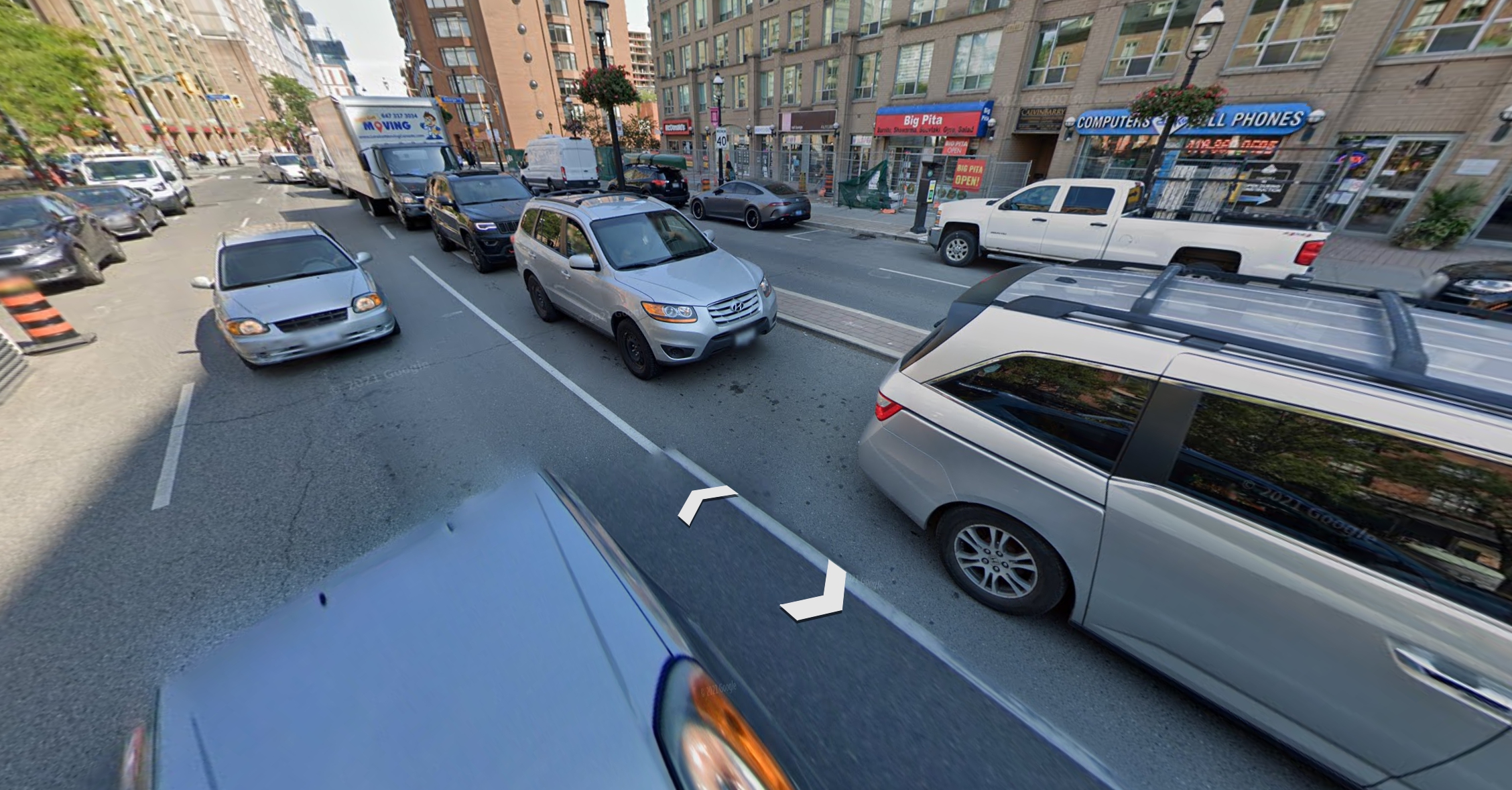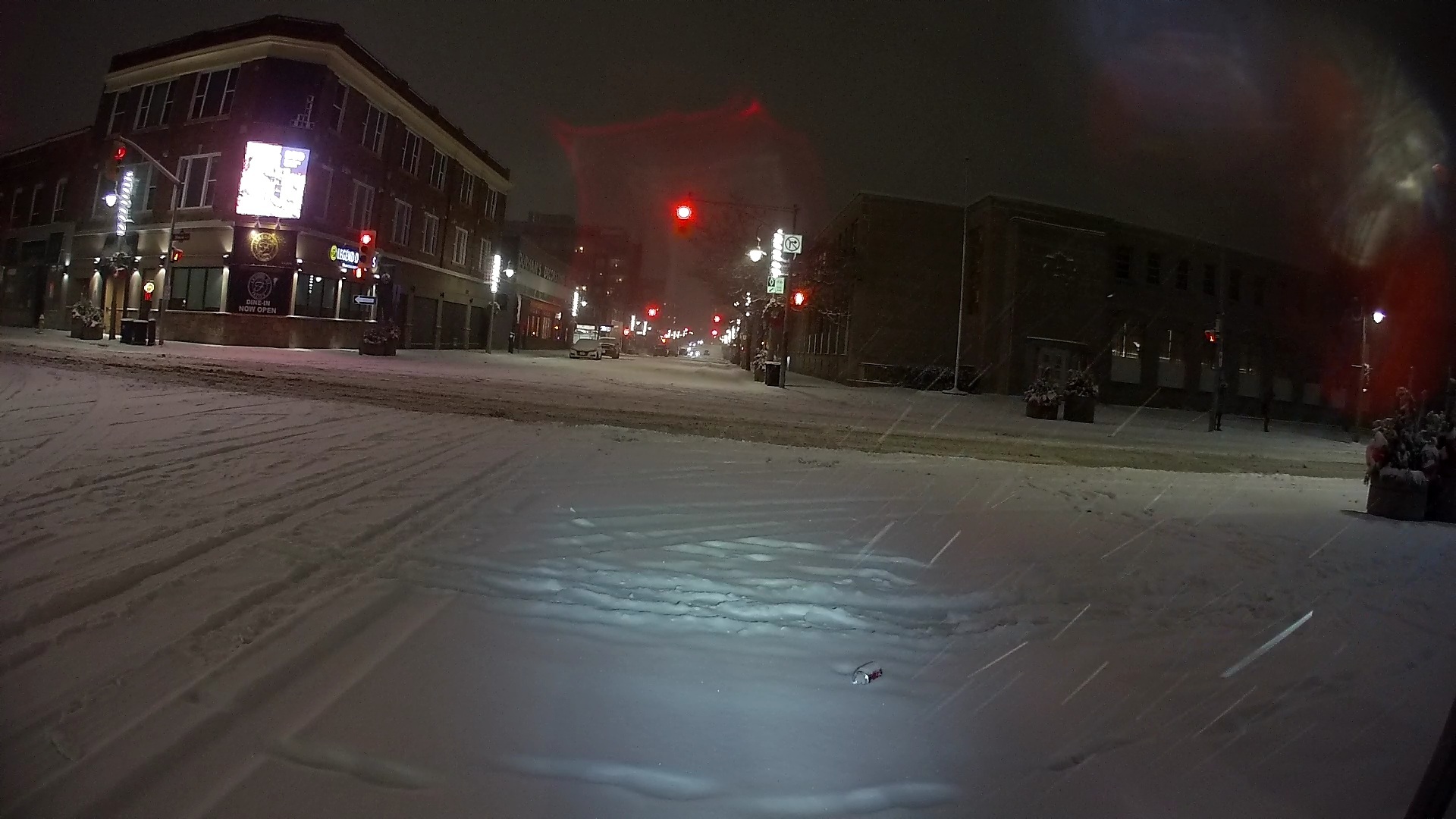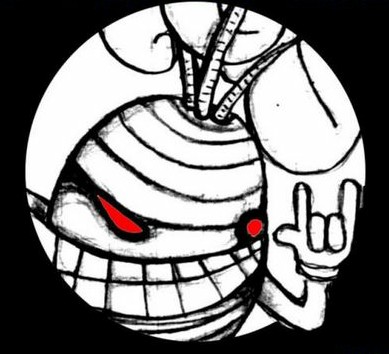Just to compare, this is the utopian dream for Toronto:

There are approx. 18 cars and trucks in that image.
They are taking up SIGNIFICANTLY more space, and are causing traffic.
Still, we keep saying, “give us more of this, please!”.
Insanity or stupidity?
And all those old buildings would be torn down and replaced with McMansions, strip malls and big-box retail outlets.
Canadian checking in. A bike will never be a replacement for a truck (the best kind of vehicle for city driving) until the front basket can be mounted high enough that the rider cannot see a child in front of them.
Pff, who needs a high basket to not see children, when you can just look down at your phone like everyone else? Rookie 😎
Best I can do is cycling with no hands while looking at your phone (yes, they do it all the time, also carrying furniture, an umbrella, or a couple drunk friends).
You can put a tall piece of furniture upright into a cargo bike, does that work for you? Should work even for blocking out adults.
Ah, btw, this is Winterthur train station, backside.



And front side.


What a beautiful sight!
the Netherlands is so great! the train station near me has a giant bike parking garage, and only like 10 car spots, which are made just for bringing and picking up people. And from then its less than an hour to get from anywhere in the ‘randstad’, the part of the Netherlands with most cities, to another.
also, most Dutch neighbourhoods (/suburbs) have a single lane road which is also used by the bikers, meaning the cars are forced to go only as fast as the bikers.
After a quick Google search, snowfall average per year in Amsterdam is 6.1cm
Toronto is apparently 121.5cm
Biking in the snow is significantly harder, and the accumulation of snow in the road in winter makes it even worse.
I don’t thin that’s the best comparison to make
Just to counter that:
Snow in Toronto would rarely cause someone to not be able to bike. In fact, the only time it might be too risky to bike, is when it’s also too risky to drive.
That said, Montreal gets more than twice the snow and colder winters compared to Toronto.
Yet they have been making an effort to encourage active transportation, and cycling over the winter has been increasing.
Even their ride share runs in the winter (it doesn’t in Toronto).
If Montreal has a few bad snow days out of a few months in the year, and is still very bikable, then we should stop making excuses that people in Amsterdam can do it only because the weather is nice and the land is flat.
Also, the least bike friendly places in North America have great weather most of the year, and snow is never a concern (Dallas, Miami, Raleigh, etc.).
I think we’re too used to making excuses to drive everywhere. It doesn’t have to be this one-sided, favouring only cars.
Edit: I posted this in another reply, but I was biking in this the other day, and I live close to Toronto (close enough to bike):

we should stop making excuses that people in Amsterdam can do it only because the weather is nice and the land is flat
The land is definitely flat, but I don’t think anyone would ever describe Dutch winters as nice. It’s not as cold as in many Canadian cities, but the wind from the North Sea and the lashings of sidewise rain aren’t easy to get used to.
Even if biking is safe when driving is safe in snowy conditions, it’s still much more annoying to be a cyclist on a snowy winter day. You either have to sweat in a ton of layers or wear flimsy ones and be chilly every time you aren’t in motion; having some environment to insulate you would be a huge advantage. I say this as someone who is not a driver but as an amateur cyclist (though not in the winter… yet).
I’m still figuring out how to make winter cycling feasible for me, and I think for most people it’s a lot of dedication and commitment that the average commuter will not want to put in. Also, icy road conditions are the worst for pedestrians and cyclists; they can be bad for cars too, of course, but obviously car tires are much bigger and can withstand much more.
I can only say this as someone who’s been a driver during Canadian winters, and also as a cyclist who rides through the winter.
Unless it’s the most miserable snow storm, like the type where I would not be driving anyway, most winter outings are worse in a car.
Since I don’t think it’s good to idle “while it warms up”, you still have to be in a cold car and battle steamy windows. You still have to scrape ice from all glass and mirrors. And then get gas when it’s cold outside (this could include going out of your way to get to a gas station, then possibly waiting while you’re there). You’d have to take the car to the car wash or risk having it rot in rust multiple times a month. And then you have to contend with finding even fewer parking spots (no on street parking around here when there’s snow). Getting around is also slower and more dangerous.
This winter has been the first where I’ve actually made an effort to do things right when it comes to cycling gear. Rather than my running shoes, which I’ve worn through past winters, I got some cheap snow shoes/boots that are insulated and keep my feet warm while riding.
And I’ve been doing layers right, and it’s SOOOOOO much better than just wearing whatever. I’ve never found myself to be too cold or sweaty, and we’re talking multi hour bike rides on a very heavy (40lbs+) manual bike, with temperatures dropping down into near -20C with the windchill! Pogies on the handlebars are a game-changer in the winter, and I’ve had them on mine for the last three.
And yes, if your city doesn’t prioritize cycling, then it can be miserable to cycle on roads where the “bike lane” is not cleared. Still, I’d rather be on a bike!
And if winter commuting by bike was something I had to do, I’d likely invest in an e-bike that could take moderately wide tires. This would eliminate the concern over being sweaty, and make it easier to get around in general.
I’m still figuring out how to make winter cycling feasible for me, and I think for most people it’s a lot of dedication and commitment that the average commuter will not want to put in. Also, icy road conditions are the worst for pedestrians and cyclists; they can be bad for cars too, of course, but obviously car tires are much bigger and can withstand much more.
Yeah, it’s hardest for pedestrians. I do give you kudos for trying to make winter cycling feasible.
Start with what you have, and take small trips by bike when the weather is “good enough”. See how that goes, then build from there!
I work in Montreal.
People biking year round are very rare, and dping so require significant effort compared to using public transit.
I’m all for reducing car usage, but what I am saying is that solutions should be tailored to location.
Bike work for Amsterdam, great!
But I think cities where snowstorm are somewhat frequent should probably focus on public transit instead.
( I’ll admit tough that I assumed Toronto weather was similar to here and didn’t expect that much less snow! )
But I think cities where snowstorm are somewhat frequent should probably focus on public transit instead.
For sure, this could be a good option, too. Anything to lessen car dependency would benefit those cities, and the people who live in them!
Half the bikes are abandoned, and one fifth is stolen. If they have the same ratios as in Rotterdam.
And every other building would have been knocked down to make room for parking
Removed by mod
Look we all want to be a pothead cyclist sex worker in the paradise of Amsterdam, but they can’t fit us all.
They have entire fried fish fillets being sold on the street for like 2€ it’s stupid bro it’s fucking stupid how good they got it.
I blame the civil engineers.
Edit: I visited Amsterdam during a work trip. They have a tram system that stops at every other street and goes up every other spoke of their bike wheel city. It’s cheap and it runs almost all night. I was sharing a jazz cigarette (Marijuana joint) with a local after drinking many fine Belgian beers and remarking about this in a broken German the local was ever so polite to entertain and they laughed at me, telling me the tram was slow, hardly stopped anywhere and cost too much, next time I should just rent a bike.
They don’t even know how good they fucking got it.
They have entire fried fish fillets being sold on the street for like 2€ it’s stupid bro it’s fucking stupid how good they got it.
I prefer the kibbeling (little chunks of battered cod). The smoked-eel sandwiches (broodje paling) are also great.
I go to smaller Dutch cities when I want a break from the neglected and incompetently-managed infrastructure of England. There are too many Vice-reading Joe Rogan fans in Amsterdam.
As for bike rental, last I checked, locals could rent an OV-fiets using an OV chipkaart (and presumbably the OV-pas coming in this year), but visitors can’t do that. I’ve heard that there are workarounds, but I’m not convinced that they can be relied on to work.
They don’t even know how good they fucking got it.
That’s because this way of city planning is normal there. You wouldn’t think that making streets and sidewalks safe for human beings would be such a big deal, but to us it’s unheard of!
When we put a pedestrian crossing with gasp, a signal, motorists around here lose their minds! Not really, they just ignore them. /s
It’s normal because people in the 70s put in a lot of effort and protesting to make it normal. I thank them every day for that.
It has nothing to do with protected historic buildings and a sweeping canal system squeezing the roads making them much too narrow for modern cars…
Thank the architects that made such a beautiful city.
You’re right, it has nothing to do with both of those things. Almost all canals are accessible by (modern) car.
Maybe do some reading before trying to be a know-it-all without knowing anything about the subject:
https://onsamsterdam.nl/artikelen/4-juni-1977-fietsdemonstratie-op-het-museumplein
https://www.amsterdam.nl/nieuws/achtergrond/strijd-tussen-auto-fiets/
Edit: just checked this guy’s post history and already regret biting
Other dutch cities, like Groningen, without so many canals, went through the same process, cars everywhere in the 70s, but a return to cyclable/walkable cities ever since. It’s a matter of voting for the right municipal politicians.
That’s because this way of city planning is normal there.
If we’re allowed to factor in “normality” here, it’s a good idea to add some context to what’s got you so ornery…
It sucks that America’s urban development came alongside the commercialization of cars, but here we are.
Yes Amsterdam is great, it’s a beautiful city with great public transportation. It tracks that a city founded in the 13th century would be designed for a population that walks everywhere.
It’s a strange comparison to make.
Perhaps in 500 years Americas infrastructure will suit whatever social transportation trend people will be arguing about online. Until then I’ll just do my best to minimize my impact and try not to be a cock.
So what is stopping america from building its new neighbourhoods in denser and more compact design like new neighbourhoods in the netherlands? Its not 1350 anymore yet they still seem to be able to build density and walkability.
Many American cities were founded before the car existed, why aren’t those neighbourhoods walkable and cycleable?
America has a big conservative streak. That’s typically why we can’t have nice things.
Conservative in both the sense of “don’t want change” and also “don’t want outgroups to have nice things”.
You might be interested in this recent video: https://www.youtube.com/watch?v=4uqbsueNvag
Change can happen very quickly, both good and bad.
There’s no reason why cities in North America have to throw up their hands and say “we can’t do anything about this.”
Plenty of places have already returned cities back to people, and many are still trying. Some seem to have given up, and others don’t want to quit their car addiction.
This is why you vote/advocate for bike friendly infrastructure to exist where you currently live.
Buddy this is suburbia that shit ain’t even on the ticket in the primary
Best thing I ever did in my life was to get out of the burbs.
Hence why I also said advocate.
If there are no relevant ballot issues, you will need to find like minded people to create petitions. Start small: Painted bike lanes, reduce speeds in neighborhoods, signage, etc
The other option is be angry and bitter on the Internet. 🤷♀️
I ain’t bitter or angry, like I said, this is suburbia, we just talk like that.
Things can change it just gonna take a generation or two. It took NL 40-50 years of development to achieve these efficiencies
Not really, it wasn’t much different in the mid-80s than it is now. Most of the change was early in the process. Beyond that, it’s mainly been improving integration of transport modes and fine-tuning some aspects of the system such as how intersections are controlled.
I’ll just drop this here

I visited there once and dear god having public transportation was awesome.
This is A bicycle parking lot at the main station in Utrecht. Now imagine to replace this amount of bycyles with cars and how much space this would take up. However, I still believe, that this is just a bicycle exchange station. You just leave your bicycle there and just grab another one when you leave. You ain’t gonna find your bicycle anyways in this huge pile of bicycle.

There also a massive indoor bike parking structure by the central station in Utrecht.
That’s a temporal bike park. Yes we do find our bikes back, it’s an innate skill.
Most modern bike parkings are two story:

You ain’t gonna find your bicycle anyways in this huge pile of bicycle.
lol the amount of bikes has nothing to do with it. By that logic you wouldn’t be able to find your car in a mega parking lot because there are so many cars. You just go to the place where you parked it? You don’t start looking at the first car and then go to the second car and so on. You go directly to where you know it is. Granted you know where it is, of course…
As a matter of fact, it’s probably more likely you would lose your car in a huge lot than likely you’d lose your bike here. This is a much smaller area to traverse and search, in case you forgot where you parked.
Also bikes have locks just like cars.
Ignore the FUD, folks, buy a bike today!
I know. It was a joke.
Ah. Something about the phrasing there sold it as something you actually believe. Maybe that you said you still believe it to be so. 😃
IIRC it’s no longer true, but there was a time when the largest bicycle parking in the world was at Utrecht Centraal (the central train station).
The second-largest bicycle parking was on the other side of that same station.
actually, we somehow do
It’s not a rental, but a normal parking, albeit a temporary one.
Unpopular opinion: getting rid of cars is good, but if you’ve ever been to the streets of Amsterdam, it’s a bike nightmare.
Streets are generally narrow, so bikers form a neverending swarm and barely regard the pedestrians. From a bikers’ perspective, you’re constantly riding in a flow, so you can’t really afford to stop or turn over for a break.
Amsterdam should either figure out how to manage that flow, or expand the public transportation like buses and trams - which are really the most compact ways to drive people around.
As a person who regularly cycles through Amsterdam (even the centre), the issus is tourist pedestrians. The city does a bare minimum to cater for these travellers, because most of the visits are temporal.
As a cyclist and/or pedestrian, I am never frustrated by locals cycling or walking.
The rule is “its harder for a cyclist to stop than a pedestrian, so be predictable with where you are going and we’ll all avoid an accident”.
The flow people you walk about is a problem for travellers, not for locals.
As a visitor, you very quickly learn to look out for bikes. They’re nearly silent and they’re everywhere. Look before you step into a bike lane or it’s going to end in tears. The problem is that, later in the evening, the tourists have some weed and a few trippels, then they’re back out on the streets again, with no remaining situational awareness.
Might be true - I haven’t been there for long enough to adapt. But in the hindsight it often felt like this rule was taken into an absolute where you might have to wait a solid minute to then swiftly run through the crossing, hoping you won’t be run over. And it’s way worse in the city center, yeah.
And how would that nightmare be if everyone was in a car?
Amsterdam doesn’t have much of a bicycle issue, really.
No better, indeed. Just pointing out that there are current issues with the way it’s organized, so there is a lot of room for improvement and it shouldn’t be seen as a perfect bike utopia it’s often posed as.
If you ask me, Scandinavian countries often have a better thought out bike infrastructure, with plenty of separate bike lanes that are planned in a way as to allow bikers and pedestrians to easily coexist and have plenty of space.
Scandi cities are far lower-density than Dutch cities.
Dutch person living in Norway: 1. Amsterdam has perhaps the worst biking infrastructure in the Netherlands, 2. It’s much better than anything you will ever find in Norway.
Speaking as someone who was thrown into being a pedestrian in this city with no training:
Just go slow and steady (don’t dash forwards) and the cyclists will go around you. Telegraph what you’re up to if you’re worried.
The only reason cars would be safer if because of how ineffective they’d be (i.e. average speed of 2km/h).
Stuff like knowing that standing on red means you’re in the bike lane makes it a lot less scary.
And yeah the worst spots are directly outside the central station, and probably on the bridges in the Jordaan. Apart from that you can pick up the rhythm in under an hour.
Thanks for your notes :)
Having cyclists all around comes with all sorts of unwritten rules, people need to get used to it for it to function properly. Amsterdam has a lot of tourist that aren’t used to the bicycle-culture, don’t know the unwritten rules, and at the same time to local populace expects them to, so that causes problems. You’ll notice that other dutch cities like Utrecht and Groningen have it figured out much better, have a far smoother experience, but perhaps have it easier because there are less tourists.
No matter how you cut it, I’d rather be hit or nearly hit by a cyclist than by a F150.
Driving comes with WRITTEN rules and drivers can’t even seem to follow them like full stops at stop signs or pedestrians having the right of way at crossings. At least with a bicycle if some rules are ignored by either side the risks are far less deadly.
The thing is that these rules are not “unwritten” at all. They are part of the (written down) traffic code. To give an example, you have pedestrian zones where you are not allowed to bike, and you have regular roads where pedestrians need to keep to the sidewalk. Also, you have bicycle paths meant for cyclists only, and sidewalks meant for pedestrians only. When you walk on the road or on a cycling path you are violating the traffic code, not some unwritten rule.
Fair!
I saw a YouTube comment on a cyclists video claiming Toronto to be “the anti-car capital of the world”. If toronto is an anti-car city, i would hate to see how a “pro-car” city looks to them…
I saw a YouTube comment
Those are almost as shit as Facebook comments.
I saw a video on YouTube calling road diets “The latest socialist assault on our freedoms!” It was from a semi-major news outlet too.
LOL. Putting in a bike lane makes any city “anti-car”, if your only perspective is seeing the city through your metal cage 😂
But really, a pro car city is probably 20 lanes for every road with no sidewalks at all. Everyone is miserable, and traffic doesn’t move. 🤭
I unironically live in a place with no sidewalks, it sucks so much
the only place where no side walk is acceptable is where there is a dirt or gravel road instead of a paved road.
I call those places “hostile to pedestrians”.
We have a few areas in my municipality that lack sidewalks, and they are in places where people work or take their kids to dance lessons. 😵
Now I want to eat Falafel. These Maoz guys made awesome falafel back in the ‘90s when I lived there.
These big American trucks are infesting our roads now too. They are technally not street legal because they are not measured to the same enviromental and safety standards compared to a European car for some reason beyond me.
The EU has not done anything yet, but there are many enviromental groups pressing the EU on getting these trucks banned.
Importing these trucks (and any truck) without paying any vehicle tax registration is getting cancelled in 2025 here in the Netherlands so let’s hope these trucks will get the fuck off our roads. This law was kind of a loop hole to import these trucks for cheap.
Quite a few of those ghastly RAM trucks where I am up in the mountains
If they find out it’s me that’s sticking the “Fuck your environment, I’m compensating for my micropenis” stickers on them, I’m fucking dead
Cheap as fuck on AliExpress
Would love to own a moped, but it stands out too much in a sea of cars to not get stolen
Apparently, using a cover while it’s locked up can significantly reduce theft.
This is the strategy that “Cargo bike momma” uses with her cargo bike, in New York City… and she’s a professor of criminology, so I trust her judgment when it comes to these things! LOL
I believe it has to do with the fact that it slows the thief down, so they consider it too risky
Yup. It causes the bike to blend into the surroundings, so it’s not as noticeable. But it creates a barrier that thieves just don’t want to deal with.
The covers thatI have even feature large grommets for your lock or a chain to go through. You couldn’t even peek under the cover to see what’s there, unless you removed the lock.
The other thing we do here is have many more cars than people. I live in a neighborhood where basically everyone has two spots per unit in their attached garage…many, many people spend a lot of their time trying to avoid parking tickets because they have to park their 3rd, 4th, 5th, and 6th cars somewhere else.
So, so, sooo much wasted money. I’ve got neighbours like that… one car for each family member. And none are driving outside the city on a regular basis.







